Abstract
The study was conducted in Suceava, Iasi, and Botosani, three geographically different cities in Romania with increasing PM10 concentrations, especially during the colder months. In order to assess the contributions of PM2.5 and PM10, the PM2.5/PM10 ratios were analyzed for the period 2019–2023. The results showed a downward trend in PM10 and PM2.5 concentrations, with a more significant decrease observed for PM2.5. However, although the annual PM2.5/PM10 ratios also decreased, their decrease did not follow the same pattern as the decrease in PM10 and PM2.5 concentrations. The annual PM2.5/PM10 ratios varied from 0.48 to 0.61 in Botosani, from 0.54 to 0.72 in Iasi and from 0.60 to 0.71 in Suceava. The seasonal analysis of the data showed that the highest ratios were observed in winter in Suceava, where wood is also used for residential heating. The frequency distribution of the ratios was examined for each season to determine the nature of the emissions: natural or anthropogenic. The analysis of the spatial variation of the PM2.5/PM10 ratio showed that the greatest differences occurred between Iasi and Botosani as indicated by a coefficient of divergence (COD) value of 0.236. Furthermore, the temperature was used to analyze its potential relationships in relation with the PM2.5/PM10 ratio.
1. Introduction
Particulate matter (PM) is one of the most dangerous pollutants for human health, the environment, and climate change. This pollutant is a primary reference for assessing air quality.
PM is a complex mixture of solid and liquid particles with different chemical and physical properties [1]. These can come from natural sources (mineral and marine) such as volcanic eruptions, soil erosion, etc., or from anthropogenic sources, which include various sources such as combustion of fuels in residential, industrial, or thermoelectric power plants, road traffic that generates emissions from incomplete combustion of fuels as well as from wear and tear on tires and road surfaces from rolling or braking, etc. [2,3].
PM can be primary, emitted directly by pollution sources, or secondary, formed in the atmosphere from chemical reactions between gaseous precursors such as sulfur dioxide, ammonia, nitrogen oxides, etc. As a result, PM concentrations and composition vary from area to area, and are influenced by background concentrations, geographic factors, emission sources, land use patterns, population density, and meteorological factors such as temperature, wind speed, atmospheric pressure, and relative humidity [4,5]. PM is classified based on its aerodynamic properties (aerodynamic diameter), as these determine transport and removal processes in the air, as well as deposition sites in the respiratory tract [1]. PMs of human health concern are PM10 (particles with an aerodynamic diameter of less than 10 µm) and PM2.5 (particles with a diameter of less than 2.5 µm) [1].
Numerous studies have shown that fine PM2.5 particles, which can reach the alveoli of the lungs, are associated with a variety of respiratory diseases [6,7], cardiovascular diseases [8,9], cancers [10], inflammation, and intoxication [11].
Directive 2008/50/EC sets a daily limit value of 50 μg/m3 (not to be exceeded more than 35 times in a year) and an annual limit value of 40 μg/m3 for PM10. In the case of PM2.5, the legislation sets an annual limit value of 25 μg/m3 [12].
Studies have shown that there is a strong positive correlation between PM2.5 and PM10 mass concentrations because PM2.5 can be an important contributor to PM10 concentrations [13,14]. Fine PM2.5 particles are more influenced by combustion sources than coarse particles [15] For example, in 2014, the PM2.5/PM10 ratio at urban background stations in the UK varied from 0.47 to 0.83 at different sites [15]; in China, Wuhan was found to be 0.62 at the same type of stations [16]. The PM2.5/PM10 ratios were reported to be between 0.29 and 0.49 in the Emirate of Abu Dhabi [17].
In urban areas, where the PM10 daily limit value of 50 μg/m3 is exceeded, determining the contribution of PM2.5 to PM10 is important because it can guide decision makers in implementing of effective local measures to reduce PM10. Therefore, the PM2.5/PM10 ratio can be a useful indicator for identifying the dominant pollutant and source of PM, and not only for PM2.5 control [15].
Analysis of the seasonal distribution of the PM2.5/PM10 ratio is an effective approach to assessing the temporal variability of pollution sources.
The approach is based on the typical behavior of the PM2.5/PM10 ratio. It depends on the type of source of the PM2.5/PM10 ratio: A higher PM2.5/PM10 ratio indicates a predominance in the contribution of PM2.5, which is mainly associated with primary pollution from anthropogenic activities [18] and the formation of secondary particles that may contain nitrates, sulfates, ammonium, and organic substances [19]. For example, in the case of biomass combustion in small residential plants, using the emission factors from EMEP/EEA 2023, the PM2.5/PM10 ratio varies in the range of 0.93–1, showing the predominance of PM2.5 [2].
When the PM2.5/PM10 ratio is less than 0.5, coarse particles predominate. These particles are generally from natural sources [20]. These sources include long-range transported sand, dust, soil erosion, fugitive dust, and emissions from activities such as mining, quarrying, and agriculture (and while most of these sources are natural activities, not all are) [16,19,21].
In Barcelona, this ratio is used to distinguish anthropogenic pollution from dust episodes [22]. For example, in agriculture, during soil cultivation, according to the EMEP/EEA 2023 emission factors [2], the PM2.5/PM10 ratio is 0.06, indicating that coarse particles from this source significantly dominate.
Therefore, analysis of the frequency distribution of this ratio over the seasons can provide valuable insight into the dominant sources affecting air quality.
In addition to anthropogenic and natural sources, meteorological conditions play a key role in the variability of these ratios. Previous studies have shown that factors such as relative humidity, precipitation, and atmospheric pressure have significant positive in-fluences on the PM2.5/PM10 ratio, while temperature and wind speed tend to decrease it [15,21,23].
The PM2.5/PM10 ratio is used when information on aerosol characteristics (size, composition, and sources of pollution) is needed [20] to assess human health effects, but also to assess the effects of climate change [23] and atmospheric processes affecting air quality [15,18]. If there is evidence of spatial-temporal variability of the PM2.5/PM10 ratio, it can be used to estimate PM2.5 or PM10 concentrations retrospectively without direct measurements [14,21].
Numerous studies have analyzed the variation of PM2.5 and PM10 concentrations and trends in PM2.5/PM10 ratios. For instance, Munir [15] showed that, due to the complexity of atmospheric processes, decreases in PM2.5 and PM10 levels are not always correlated with decreases in PM2.5/PM10 ratios. The values of PM2.5/PM10 ratios were found to vary significantly from place to place and are influenced by local and regional factors [20].
For the northeastern region of Romania, Bodor et al. [24] estimated the PM2.5/PM10 ratio to be 0.68 for the period 2009–2018, considering all types of monitoring stations. In contrast, the current study, focusing only on urban background stations, provides a more accurate assessment by avoiding mixed emission sources.
Therefore, the PM2.5/PM10 ratio is a key indicator of fine particulate matter, and it is essential to analyze its spatial and temporal variations.
This study aimed to determine the PM2.5/PM10 ratios at three urban background stations from the Romanian National Air Quality Monitoring Network (https://www.calitateaer.ro): SV-1, IS-2, and BT-1, where both PM fractions are measured in order to assess the contributions of PM2.5 and PM10 in three geographically distinct urban areas—Suceava, Iasi, and Botoșani—over the five-year period of 2019–2023.
Specific objectives for the three urban areas included:
- -
- To analyze the trends in PM2.5/PM10 ratios and PM2.5 and PM10 concentrations, and the correlation relationships between PM2.5/PM10 ratios and PM2.5 and PM10 concentrations by season;
- -
- To analyze the frequency distribution of PM2.5/PM10 ratios in each season, namely, spring (March–May), summer (June–August), autumn (September–November), and winter (December–February), to determine the nature of natural or anthropogenic emissions;
- -
- To investigate the relationship between the PM2.5/PM10 ratio and temperature;
- -
- To analyze the spatial variation of the PM2.5/PM10 ratio in the three urban areas.
2. Materials and Methods
2.1. Study Area
Suceava, Iasi, and Botosani (illustrated in Figure 1) are three cities in the northeast of Romania, in a region characterized by a temperate continental climate with cold winters and warm summers. These cities were chosen for the study because of their differences in geography and degree of urbanization, factors that influence the distribution and intensity of air pollution.
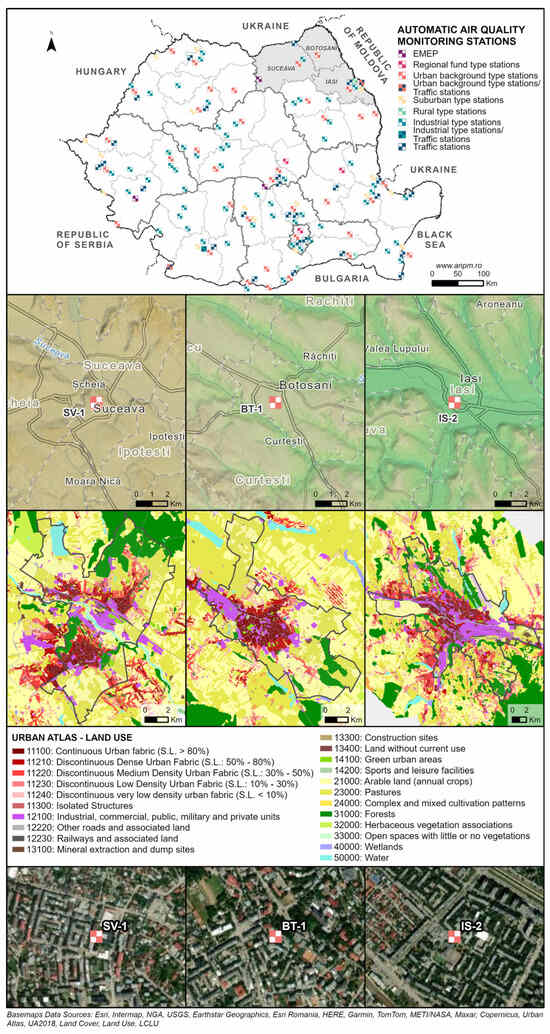
Figure 1.
Map of the study area with locations of the urban background stations.
In winter, atmospheric circulation is often dominated by cold and stable air masses from northeastern Europe, favoring thermal inversions that reduce air dispersion and lead to the accumulation of pollutants in the lower layer of the atmosphere. In summer, the meteorological regime becomes more dynamic, with increased dispersion potential due to convection and active winds. These climatic conditions, together with the local characteristics of each city, contribute to the spatial and temporal variability of air quality in the region [25,26].
Iasi, the largest city in northeastern Romania, previously described from a climatic point of view in [25,27], is highly urbanized with a dense population of 4143 inhabitants/km2 in 2024 [28], heavy traffic, and industrial activities driving air pollution, particularly in central areas, while peripheral neighborhoods contribute through the use of solid fuels for heating in winter.
Suceava, previously described from a climatic point of view in [26], has an intermediate degree of urbanization with 2279 inhabitants/km2 in 2024 [28]. Air pollution comes from energy, industrial sources, heavy road traffic in certain areas, and residential burning of solid fuels in outlying neighborhoods, which is a major source of emissions.
Botosani, a smaller city compared to the other two, has moderate urbanization and a population density of 2763 inhabitants/km2 in 2024 [28]. Its extensive residential areas result in a wider distribution of pollution sources. Pollution levels are influenced by road traffic, the concentration of economic activities in the city center, and the use of solid fuels for heating in the peripheral neighborhoods in winter.
The sources of air pollution present in the cities of Suceava and Botosani are described in [29].
2.2. Data Analysis
The data used in the study come from three urban background stations—SV-1 (47.649259° N, 26.249009° E at an altitude of 376 m), BT-1 (47.739945° N, 26.658999° E at an altitude of 167 m), and IS-2 (47.150951° N, 27.581920° E at an altitude of 42 m) of the Romanian National Air Quality Monitoring Network (RNMCA)—obtained using the reference gravimetric method on pre-weighed and preconditioned filters (reference method established by Directive 2008/50/EC) for the study period 2019–2023. The data are available to the public on the website https://www.calitateaer.ro (accessed on 14 August 2024). In Romania, the RNMCA stations comply with the requirements of Directive 2008/50/EC as regards their location, the monitoring methods used, and other relevant conditions.
The criteria used to select the cities and stations for the study included:
- -
- Coverage of a variety of urban areas with different topography and population density;
- -
- Availability of valid daily PM2.5 and PM10 data obtained by the gravimetric method;
- -
- Only data available for both PM2.5 and PM10 concentrations on the same day were included. Invalid ratios were excluded due to missing a PM fraction.
The population density for each of the three cities has been calculated using statistical data [28].
The PM10 and PM2.5 data used in this study are daily average concentrations, with each data point representing a 24 h period. These daily values were the basis for the statistical and correlational analyses performed in the study.
The variability of PM10 and PM2.5 concentrations was analyzed using the following statistical parameters: mean, media, 75th percentile (P75), 90.4th percentile (P90.4), minimum, and maximum. These parameters are similar to those used in other studies and reports [30]. The basic parameters of the descriptive statistics of the PM2.5/PM10 ratios at each station are also presented. Monthly/annual averages of the PM2.5/PM10 ratios are summarized from daily PM2.5/PM10 ratios.
Pearson correlation analysis was used to examine the relationship between PM10 and PM2.5, as well as between PM and the PM2.5/PM10 ratio.
To better identify the sources of PM, whether anthropogenic or natural, and to correctly interpret the seasonal variability, PM2.5 was separated from the coarse fraction (PM2.5–10), calculated as the difference between PM10 and PM2.5. To further support source attribution and interpretation of the PM2.5/PM10 ratio, additional combustion-related gaseous pollutants (CO, NO2, and SO2) were included in the analysis. These pollutants are widely recognized as markers of anthropogenic combustion sources that are major contributors to PM. Their inclusion allows for a more comprehensive understanding of the seasonal and spatial variability of the PM2.5/PM10 ratio, especially in areas or periods where combustion emissions play a dominant role.
The seasonal distribution of the PM2.5/PM10 ratio was analyzed to assess the temporal variability of pollution sources. Frequency distribution plots were generated for each season to observe the typical behavior of the ratio. A higher frequency of elevated PM2.5/PM10 values during the cold season was interpreted as an indication of dominant anthropogenic sources, whereas lower ratios during the warm season were associated with a greater influence of natural sources. Similar approaches have been used previously to interpret the seasonal behavior of particulate matter and to infer dominant source contributions [15,16,18,31].
For the seasonal analysis of PM2.5/PM10 ratios, the seasonal division was as follows: spring (March, April, May), summer (June, July, August), autumn (September, October, November), and winter (December, January, February).
The coefficient of variation (CV), the coefficient of divergence (COD), and the Pearson coefficient were used to assess the spatial variation of PM2.5/PM10 ratios in the three urban areas.
3. Results and Discussion
3.1. Variation of Particulate Matter (PM10 and PM2.5)
The mean, median, 75th percentile, 90.4th percentile, minimum, and maximum concentrations of PM10 and PM2.5 are presented in Figure 2.
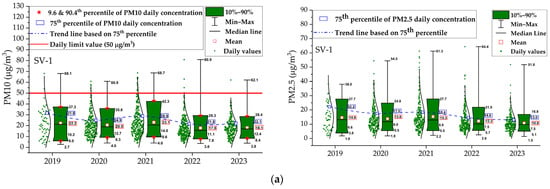
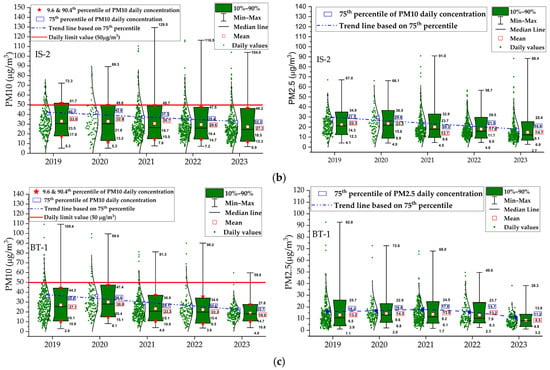
Figure 2.
Multiannual variation of PM10 and PM2.5 concentrations in urban background stations SV-1 (a), IS-2 (b), and BT-1 (c). From bottom to top, the values on the right side of the box plot represent: 1—the minimum value; 2—the 10th percentile; 3—the 25th percentile; 4—the mean; 5—the 75th percentile; 6—the 90th percentile; 7—the maximum value.
The highest concentrations were recorded in Iasi, when the maximum daily PM concentrations reached 149.45 μg/m3 for PM10 on 20 December 2019 (when no daily PM2.5 data was available) and 91 μg/m3 for PM2.5 on 26 February 2021. In 2019, there were 36 daily exceedances of the 50 μg/m3 limit value in Iasi, exceeding the maximum number of 35 exceedances/year, according to Law 104/2011.
In Suceava, the maximum daily PM concentrations reached 80.86 μg/m3 for PM10 and 64.38 μg/m3 for PM2.5, both concentrations measured on 22 December 2022. Most of the exceedances of the daily limit value were recorded in 2021 (13 exceedances).
In Botoșani, the maximum daily PM concentrations reached 114.27 μg/m3 for PM10 on 9 January 2020 (when no daily PM2.5 data was available) and 92.75 μg/m3 for PM2.5 on 7 December 2019. Most daily exceedances of the limit value were recorded in 2020 (21 exceedances).
In 2019, the 90.4th percentile indicator for PM10 slightly exceeded the 50 μg/m3 limit value at IS-2, recording 51.7 μg/m3, while no exceedances were recorded at BT-1 and SV-1.
The analysis of the annual averages shows a decreasing trend in PM10 and PM2.5 concentrations at all three stations, with different reduction rates between the two types of particles. During the analyzed period, the annual means at all 3 stations remained below the annual limit values of 40 μg/m3 for PM10 and 25 μg/m3 for PM2.5.
A decrease in the mean, median, and P75 concentrations of PM2.5 and PM10 were observed in 2023 compared to 2019 at all stations analyzed. Slight increases of PM10 and PM2.5 were observed in 2021.
The analysis of the correlation between PM2.5 and PM10 during the study period (Table 1) showed a strong positive correlation, which probably indicates a common source of emissions for both fractions [32]. It may also be influenced by factors such as proximity of different sources, common meteorological conditions, or simultaneous transport within the same air mass.

Table 1.
Pearson’s coefficient (R) between PM10 and PM2.5.
3.2. Temporal Variability of PM2.5/PM10 Ratios
3.2.1. Annual Variation of PM2.5/PM10 Ratios
During the period analyzed, PM2.5/PM10 ratios varied from year to year and among different areas, ranging from 0.60 to 0.71 at SV-1, from 0.54 to 0.72 at IS-2, and from 0.48 to 0.61 at BT-1 (Figure 3).
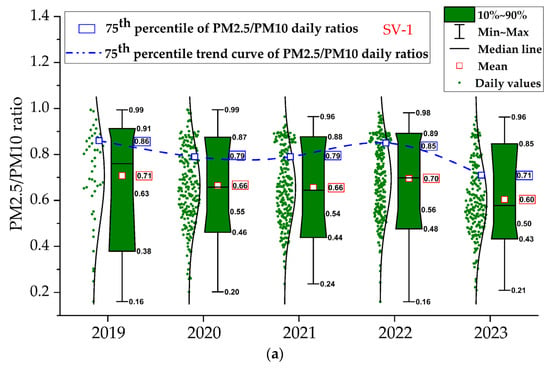
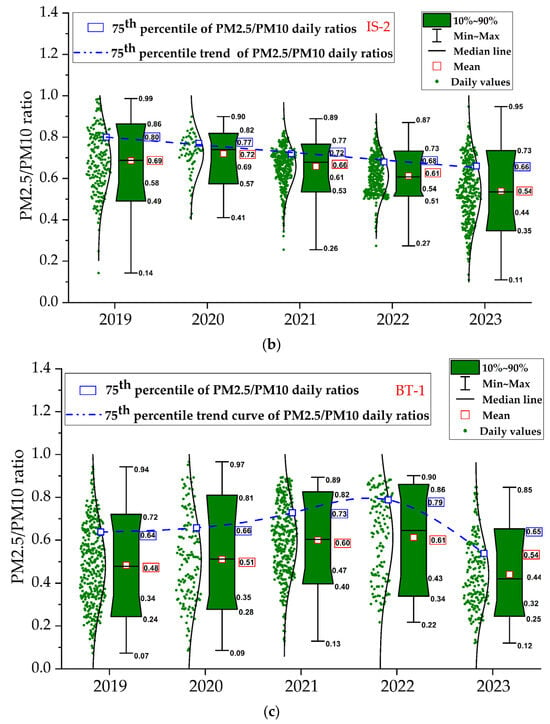
Figure 3.
Annual variation of PM2.5/PM10 ratios in urban background stations SV-1 (a), IS-2 (b), and BT-1 (c). From bottom to top, the values on the right side of the box plot represent: 1—the minimum value; 2—the 10th percentile; 3—the 25th percentile; 4—the mean; 5—the 75th percentile; 6—the 90th percentile; 7—the maximum value.
The average PM2.5/PM10 ratios for the study period were 0.66 at SV-1, 0.54 at BT-1, and 0.62 at IS-2, indicating different particle compositions, especially in Botosani compared to the other two urban areas. These differences can be attributed to variations in background concentrations and different emission sources [33].
3.2.2. Monthly Variation of PM2.5/PM10 Ratios Compared to Monthly Variation of PM10 and PM25 Concentrations Monthly Variation of CO, NO2, and SO2 Concentrations—Monthly Variation of PM2.5 and PM2.5–10
Figure 4 shows the monthly variation of PM2.5 and PM10 concentrations together with the variation of the PM2.5/PM10 ratio. It can be seen that the highest PM2.5/PM10 ratios occur in the winter months, when the peak PM concentrations coincide with the burning of residential heating fuels. During the cold season, meteorological conditions unfavorable for the dispersion of pollutants prevail, such as temperature inversion, light winds, or atmospheric calm, a phenomenon confirmed by other studies carried out in European cities [34].
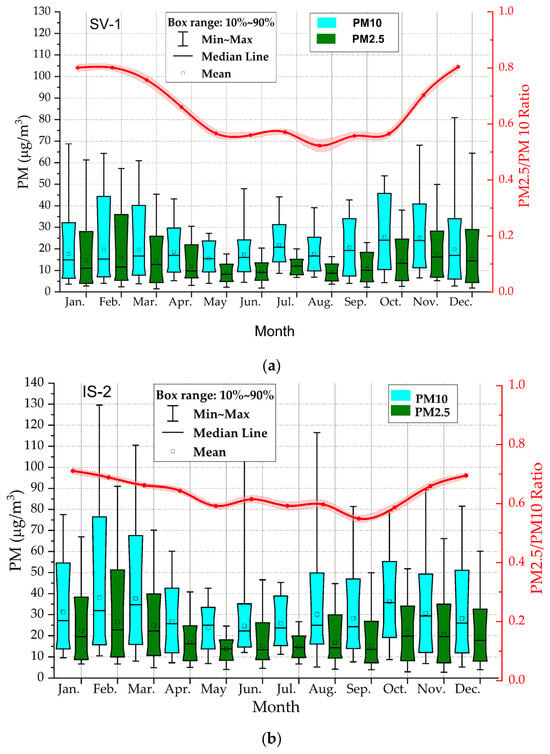
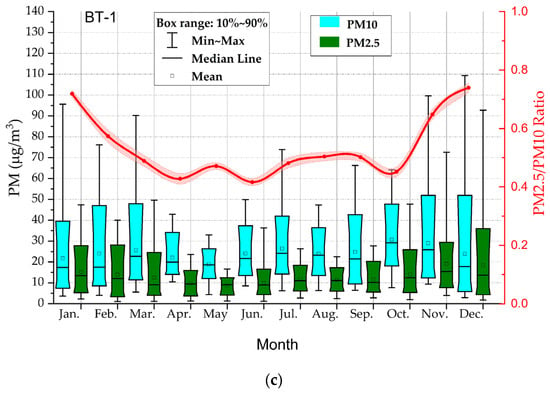
Figure 4.
Average monthly variation of PM concentrations compared to the variation of PM2.5/PM10 ratios at urban background stations SV-1 (a), IS-2 (b), and BT-1 (c), 2019–2023.
Analysis of the correlation between the PM2.5/PM10 ratio and the PM10 and PM2.5 concentrations shows a negative correlation with PM10 and a positive correlation with PM2.5 (Table 2). This suggests that variations in the ratio are more strongly influenced by PM2.5 concentrations, although this relationship is also affected by the mathematical dependence between the two fractions.

Table 2.
Pearson’s correlation coefficients (R) between PM10, PM2.5, and the PM2.5/PM10 ratio.
Monthly Variation of CO, NO2, and SO2 Concentrations
The monthly pattern of the PM2.5/PM10 ratio is supported by the seasonal trends observed for the gaseous pollutants: CO, NO2, and SO2 (see Supplementary Materials: Tables S13–S15 and Figure S1). CO is not monitored at IS-2 and was therefore excluded from the analysis for this site.
CO and NO2 concentrations peak in the winter months and decrease in the summer, which is consistent with increased combustion-related emissions (e.g., residential heating, traffic) during cold periods. These patterns are consistent with the elevated PM2.5/PM10 ratios during winter, reinforcing the interpretation that fine particles dominate under conditions of high anthropogenic activity and atmospheric stability.
In contrast, SO2 levels remained low and stable throughout the year, reflecting the absence of significant local sulfur-emitting sources, more evident at IS-2 and SV-1.
Monthly Variation of PM2.5 and PM2.5–10
In order to better identify the sources of PM as anthropogenic or natural and to correctly interpret the seasonal variability, the fine fraction (PM2.5) was separated from the coarse fraction (PM2.5–10), calculated as the difference between PM10 and PM2.5.
The monthly analysis showed that PM2.5 shows high values in cold months, reflecting the influence of anthropogenic emissions (heating systems, etc.). In contrast, PM2.5–10 concentrations tend to increase in the warm season, especially at stations BT-1 and SV-1, indicating a contribution from natural sources such as resuspended dust, agricultural activities, etc. (Figure 5)

Figure 5.
Monthly average concentrations of PM2.5 and PM 2.5–10 for stations BT–1, IS–2, and SV–1 (2019–2023).
3.2.3. Seasonal Variation of PM2.5/PM10 Ratios
Figure 6 presents, in density plot graphs, the correlation between PM concentrations and the PM2.5/PM10 ratios in Suceava over four seasons. It was found that:
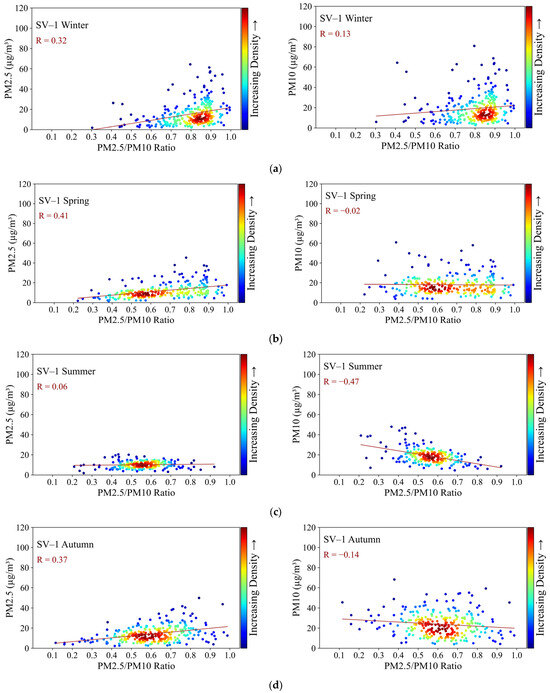
Figure 6.
Correlation of PM2.5 and PM10 concentrations with PM2.5/PM10 ratios in SV–1 in the seasons of winter (a), spring (b), summer (c), and autumn (d), 2019–2023.
- PM10 concentrations and PM2.5/PM10 ratios showed a weak positive correlation in winter (R = 0.13) and a negative correlation in the other three seasons.
- During the winter season, most the PM2.5/PM10 ratios are in the range of 0.8–0.9, due to PM2.5 concentrations of about 14.6 μg/m3. The emission sources for these concentrations are mainly residential combustion plants, energy combustion plants, and road traffic. As the PM2.5/PM10 ratios tend to increase, an increase in PM2.5 concentrations is observed, with a slope of 31.4 μg/m3. The increase in the PM2.5/PM10 ratio is directly proportional to the increase in PM2.5 concentrations (R = 0.32).
- In spring and autumn, most PM2.5/PM10 ratios are in the range of 0.5–0.7 due to PM2.5 concentrations around 10 μg/m3. Anthropogenic emission sources are lower in these two seasons than in the winter season. The increase in the PM2.5/PM10 ratio is directly proportional to the increase in PM2.5 concentrations, R = 0.41 in spring and R = 0.37 in autumn.
- In summer, the correlation between PM2.5 and the PM2.5/PM10 ratio decreases (R = 0.06) and the values of most PM2.5/PM10 ratios are between 0.5 and 0.6, which confirms the decrease in anthropogenic fine particle emissions. The high negative R between PM10 and PM2.5/PM10 (R = −0.47) suggests an inversely proportional behavior between PM10 concentrations and the analyzed ratio in the summer season. This behavior can be explained by a more pronounced decrease in PM2.5 concentrations in the warm season, most likely due to the absence of combustion sources (such as residential heating), but also due to a more efficient atmospheric dispersion.
In order to identify the type of emission, either natural or anthropogenic, the frequency distribution of PM2.5/PM10 ratios in each season during the study period 2019–2023 was analyzed.
In Suceava, according to Figure 7, the following results were obtained:
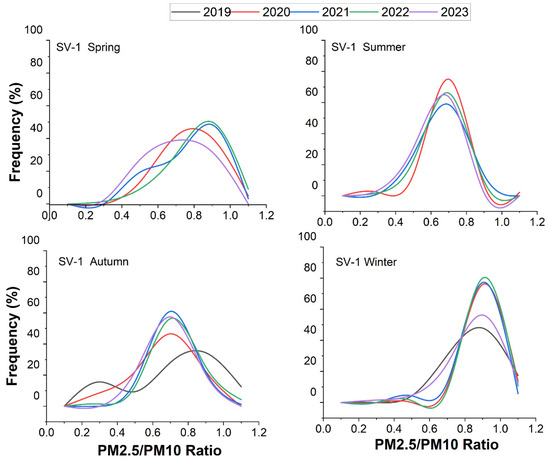
Figure 7.
Annual frequency distribution of PM2.5/PM10 ratios by season at SV-1.
- In 2023, the PM2.5/PM10 ratios with values ≤ 0.5 were in the following proportions: 6.3% in winter, 29.4% in spring, and 34.5% in summer, increasing the frequency of these ratios compared to previous years. This trend indicates an increase in emissions from natural sources. In the autumn season, there was a significant increase in the frequency of PM2.5/PM10 ratios ≤ 0.5 in 2020 (31%), followed by a decrease from 2021 to 2023, reaching 22.2% in 2023.
- In the winters of 2020–2022, the frequency of PM2.5/PM10 ratios above 0.7 ranged from 75.9% to 80%, decreasing to 56.3% in 2023. In the winters of 2021 and 2022, an increase in high ratios (0.7–0.9) was observed despite a slight decrease in PM2.5 concentrations, suggesting that the variations in ratios are independent of PM2.5 trends.
- In the autumn season, the lowest frequency of ratios > 0.5 (69%) occurred in 2020, followed by slight increases in 2021 (84%) and 2022 (86%).
The complete data, organized by season and site, are available in the Supplementary Materials (Tables S1–S4).
These trends suggest that in spring, summer, and winter, the contribution of PM2.5 from PM10 was lowest in 2023, indicating a higher contribution from anthropogenic sources in 2020–2022. Confirmation of this phenomenon requires comparison with county emission inventories and analysis of meteorological conditions. Data for spring and summer of 2019 are not available.
In Suceava the Air Quality Plan of the city of Suceava is being implemented for the PM10 parameter, which sets the deadline for the implementation of PM10 reduction measures for the period 2023–2027 [35]. The decrease in the frequency of ratios with high values, indicating anthropogenic emissions, can also be attributed to the implementation of measures from this plan.
Since the frequency of PM2.5/PM10 ratios in the ranges >0.5–0.7 and >0.7–0.9 increased during the spring–autumn seasons of 2021 and 2022, these data were compared with the emissions of the two large woody biomass combustion plants (total thermal capacity of 104 MW) in Suceava City. The comparison also took into account that in 2021–2022 these plants operated for more hours, produced more energy, and had higher fuel consumption than in the previous period (http://apmsv.anpm.ro/, accessed on 14 August 2024). Strongly positive Pearson coefficients were obtained (R = 0.68 for the first quarter of the years 2020–2023 and R = 1 for the third quarter of the years 2020–2023). The distance to the SV-1 of this plant is about 2 km, and it is not possible to estimate with precision whether or not these emissions caused an increase in the PM2.5/PM10 ratios or not.
In Iasi, according to Figure 8, PM10 concentrations and PM2.5/PM10 ratios showed a weak positive correlation in winter (R = 0.1) and a negative correlation (R = −0.31) in the other three seasons.

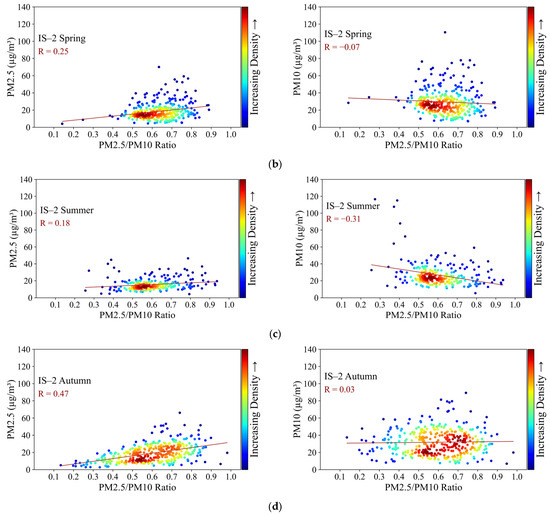
Figure 8.
Correlation of PM2.5 and PM10 concentrations with PM2.5/PM10 ratios in IS−2 in the seasons of winter (a), spring (b), summer (c), and autumn (d), 2019–2023.
- During the winter, most of the PM2.5/PM10 ratios are in the range of 0.65–0.75, determined by PM2.5 concentrations with peaks of around 20 μg/m3. The emission sources for these concentrations are anthropogenic in origin and different in composition from Suceava, which shows lower ratios. As the PM2.5/PM10 ratio increases, the PM2.5 concentrations increase proportionally, reaching a maximum slope of 50.4 μg/m3. The relationship between the increase in the ratio and PM2.5 concentrations is confirmed by R = 0.31.
- In spring and autumn, most PM2.5/PM10 ratios are in the range of 0.5–0.65 and are influenced by PM2.5 concentrations with maxima of about 15 μg/m3. During these periods, anthropogenic emission sources are lower than in the winter season. The increase in the PM2.5/PM10 ratio is directly proportional to the increase in PM2.5 concentrations (R = 0.25 in spring and R = 0.47 in autumn).
- In summer, most ratios are in the range 0.5–0.6 and the correlation between PM2.5 and PM2.5/PM10 ratios decreases significantly (R = 0.18), which confirms the reduction of anthropogenic fine particle emissions in this season. The high negative R between PM10 and PM2.5/PM10 (R = −0.31) suggests an inversely proportional behavior between PM10 concentrations and the PM2.5/PM10 ratio. This behavior can be explained by a more pronounced decrease in PM2.5 concentrations in the warm season, most likely due to the absence of combustion sources (such as residential heating), but also due to more efficient atmospheric dispersion.
In Iasi, according to Figure 9, the following results were obtained:
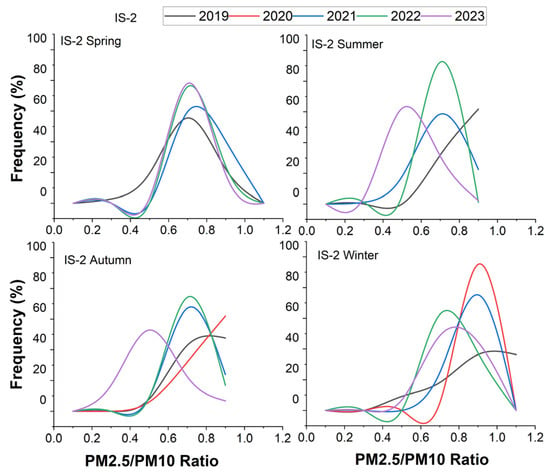
Figure 9.
Annual frequency distribution of PM2.5/PM10 ratios by season at IS-2.
- In winter, the PM2.5/PM10 ratios are generally higher than 0.5, with small exceptions: 9.1% of the 2019 and 6.8% of the 2023 PM2.5/PM10 ratios are in the range of 0.3–0.5. During 2020–2022, PM2.5/PM10 ratios higher than 0.7 were observed in proportions ranging from 37.5% to 95%, indicating a different particle composition compared to that in Suceava.
- In spring, PM2.5/PM10 ratios with values ≤ 0.5 were observed, accounting for 22.2% in 2019 and only 3.3% in 2023.
- In summer, natural sources contribute the most (66.7% of the PM2.5/PM10 ratios are less than 0.5) in 2023. Data for summer 2020 could not be processed due to a lack of data.
- In autumn, anthropogenic sources seem to contribute significantly in 2019–2022. In 2023, the contribution decreases to 29.2%.
The complete data, organized by season and site, are available in the Supplementary Materials (Tables S5–S8).
In conclusion, the contribution of PM10 to PM2.5 in Iasi in 2023 is lower in winter and summer compared to 2020–2022, and in autumn compared to 2019–2022. This trend of decreasing ratios in each season suggests a decrease in anthropogenic emissions. A comparison of these data with the county emission inventory would further support this conclusion.
In Iasi, the Integrated Air Quality Plan for NO2/NOx and PM10/PM2.5 indicators [36] is being developed, and the decrease in the frequency of high PM2.5/PM10 ratios in 2023 can be attributed to the implementation of measures from this plan, initiated in 2021.
Figure 10 illustrates the correlation between PM2.5 and PM10 concentrations and the PM2.5/PM10 ratios in Botoșani during the four seasons. The results showed that:
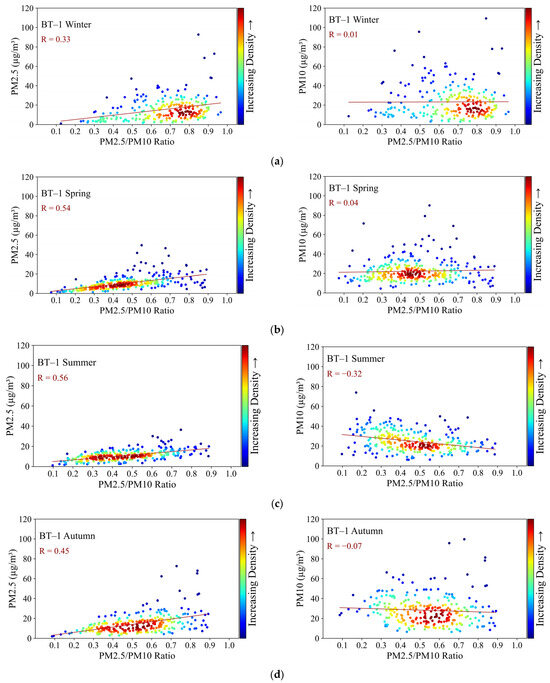
Figure 10.
Correlation of PM2.5 and PM10 concentrations with PM2.5/PM10 ratios in BT-1 in the seasons of winter (a), spring (b), summer (c), and autumn (d), 2019–2023.
- PM10 concentrations and PM2.5/PM10 ratios have a non-significant correlation in spring (R = 0.04) or negative correlation in summer (R = −0.32).
- During the winter season, most PM2.5/PM10 ratios fall within the range of 0.65–0.85 due to PM2.5 concentrations around 10 μg/m3, suggesting that these concentrations originate from anthropogenic sources. As PM2.5/PM10 ratio values increase, PM2.5 concentrations rise with a slope of 22.2 μg/m3. The increase in the PM2.5/PM10 ratio is directly proportional to the increase in PM2.5 concentrations (R = 0.33).
- In spring and autumn, most PM2.5/PM10 ratios range between 0.3–0.65 due to PM2.5 concentrations with maxima of 20 μg/m3. The anthropogenic emission sources are lower compared to the winter season and differ from the Suceava sources and from the Iasi sources. In these two seasons are also ratio values ≤ 0.5, indicating the presence of emissions from natural sources. The increase in the PM2.5/PM10 ratio is directly proportional to the increase in the PM2.5 concentrations, with R = 0.54 in spring and R = 0.45 in autumn.
- In summer, a different behavior is observed compared to other urban areas, with a much stronger correlation between PM2.5 concentrations and the PM2.5/PM10 ratio (R = 0.56). Most of the ratios are in the range of 0.3–0.6, confirming the presence of both anthropogenic and natural emissions during this season.
By analyzing the seasonal and annual variations of the frequency of PM2.5/PM10 ratios in Botosani (Figure 11), the following observations can be made:
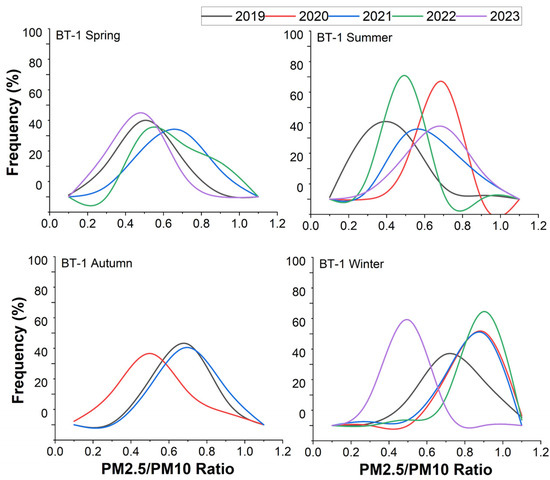
Figure 11.
Annual frequency distribution of PM2.5/PM10 ratios by season at BT-1.
- In winter, the frequency of PM2.5/PM10 ratio values ≤ 0.5 increased significantly in 2023, reaching 88.5%, compared to previous years.
- In the spring of 2023, 84.4% of the PM2.5/PM10 ratios were below 0.5, marking a significant increase from 42.9% in spring 2022.
- In the summer of 2022, there was a significant increase in the distribution of PM2.5/PM10 ratios, with a contribution of 96.2%, followed by a decrease in 2023, with a contribution of 34.2%. This suggests an increase in anthropogenic emissions in the summer of 2023. Data for the spring 2020 season were not available.
- The number of PM2.5/PM10 ratios above 0.5 was highest in the winters of 2019–2022. However, this number decreased significantly in the winter of 2023 (11.5% in 2023 compared to 81.3% in 2019). In the summer of 2022, the distribution of PM2.5/PM10 ratios decreased significantly, but increased in 2023.
- In the autumn season, the number of PM2.5/PM10 ratios >0.5 increased in 2021 compared to 2020 (45.2%). Data were not available for the autumn seasons of 2022 and 2023.
- Both trends indicate that the higher PM2.5 contribution of PM2.5 from PM10 is lowest in 2023 in the spring and winter seasons. Analysis of the data shows that anthropogenic emission sources in these seasons are highest in 2020–2022. A comparison of these data with county emission inventories is useful to confirm this phenomenon.
The complete data, organized by season and site, are available in the Supplementary Materials (Tables S9–S12).
A common feature of the three urban areas is that the highest ratios occurred in winter, i.e., the highest PM2.5 pollution occurred in the season with the lowest air temperatures, under meteorological conditions unfavorable for the dispersion of pollution including atmospheric calm, temperature inversions, low precipitation, and haze. This result is also consistent with the fact that PM2.5 is the main component of winter haze episodes [37].
The differences In the PM2.5/PM10 ratio values between winter and the other seasons are mainly caused by emissions from heating plants and unfavorable meteorological conditions, which limit the dispersion of pollutants. In winter, PM2.5 is either directly emitted during combustion or formed by chemical reactions between Nox, SO2, and oxidants (e.g., OH radicals, ozone), leading to secondary aerosols such as nitrates and sulfates [38].
The variations in the ratios presented indicate that the PM2.5/PM10 ratio is interdependent with PM10 and PM2.5 concentrations, rather than being directly linked to their individual values. This suggests that the PM2.5/PM10 ratio can provide deeper insights into the sources and characteristics of pollution.
3.3. Spatial Variations of PM2.5/PM10 Ratios
The methods of using coefficient of variance (CV), coefficient of divergence (COD), and correlation analysis, respectively, reflect spatial heterogeneity from different perspectives [31]. CV and COD are two statistical methods used to analyze variations and relationships between data. CV represents the differences within an area, while COD and correlation analysis explore the differences between two areas.
As shown in Table 3, the CV of the PM2.5/PM10 ratio at the three stations was greater than 0.210, indicating significant variability. This suggests that there is considerable heterogeneity in PM pollution across in these areas, with pollution levels varying significantly from one location to another, possibly due to an uneven distribution of emission sources [39].

Table 3.
Mean, coefficient of variance, and coefficient of divergence of the PM2.5/PM10 ratios (2019–2023).
The COD value reflects the regional similarity; a higher value means greater differences between two analyzed areas. For correlations, only periods with available data for both stations included in the analysis were considered. The results are shown in Table 3, the highest values are between BT-1 and IS-2 indicating the largest differences between the PM2.5/PM10 ratios of these stations.
The correlation analysis indicates the positive or negative correlation of the relationship between the two areas, and the Pearson correlation coefficients have been presented in Table 4. The highest, weakly positive correlation coefficient was between SV-1 and IS-2 (0.441), indicating a modest linear relationship based on the analyzed ratios during the study period.

Table 4.
Pearson correlation coefficients between PM2.5/PM10 ratios (2019–2023).
3.4. Distribution of PM2.5/PM10 Ratios in Relation to Temperature
PM2.5 appears to be the most sensitive to changes in temperature, regardless of the season, compared to changes in other meteorological parameters [40].
Figure 12 illustrates the effect of temperature on PM2.5/PM10 ratios:
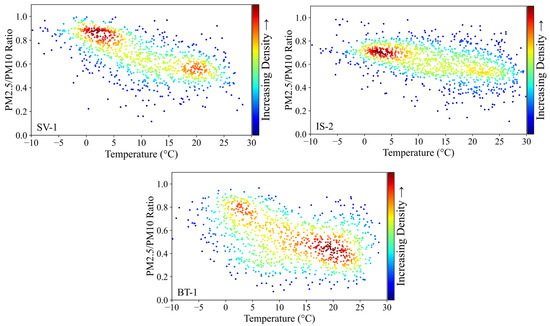
Figure 12.
Distribution of PM2.5/PM10 ratios in relation to temperature, 2019–2023.
- PM2.5/PM10 ratios with the highest values in Suceava (0.9) and Botoșani (0.7–0.9) are most often found on days with temperatures between 0–5 °C.
- In Iasi, PM2.5/PM10 ratios in the range of 0.7–0.75 are frequent on days with temperatures between 0–2.5 °C.
- An increase in PM concentrations up to a temperature of 5 °C followed by a decrease was observed by Czarnecki et al. This phenomenon emphasizes the role of anthropogenic activities, especially the combustion of fuels for residential heating, during periods of low temperatures [41].
- In Botoșani, PM2.5/PM10 ratios with values between 0.3–0.5 are frequent, showing the predominance of coarse particles recorded at temperatures around 20 °C.
The PM2.5/PM10 ratio showed a negative correlation with temperature at low temperatures, indicating that the two indicators are inversely proportional in all three cities.
The observed negative correlation between temperature and the PM2.5/PM10 ratio, and implicitly PM2.5 concentrations, is not a direct causal effect of temperature alone, but rather the result of a combination of anthropogenic and meteorological factors occurring simultaneously during the cold season.
In particular, low temperatures lead to increased emissions from the burning of solid fuels (e.g., wood in Suceava and in the neighboring urban areas of Botosani and Iasi), which contribute significantly to the PM2.5 levels. In parallel, the studied area is characterized by frequent atmospheric stability and thermal inversions in winter, which allow the accumulation of pollutants at ground level.
4. Conclusions
In this study, three different urban areas in northeastern Romania were analyzed, focusing on the PM2.5/PM10 ratio.
The main conclusions drawn from the data analysis for the analyzed period, 2019–2023, are as follows:
- The analyzed statistical parameters for PM10 and PM2.5 concentrations indicate an improvement in air quality, reflected by lower values in 2023 compared to 2019 in all three urban areas.
- The PM2.5/PM10 ratios decreased, but not with the same trend as the PM10 and PM2.5 concentrations.
- The PM2.5/PM10 ratios varied from year to year and between different areas, ranging from 0.48 to 0.61 at BT-1, from 0.54 to 0.72 at IS-2, and from 0.60 to 0.71 at SV-1.
- Seasonally, the PM2.5/PM10 ratio was highest in winter in Suceava, where biomass heating is used, followed by Iasi and Botoșani, correlating with low temperatures and high PM2.5 concentrations. In Suceava, most of the PM2.5/PM10 ratios in winter showed that 80–90% of PM10 originated from PM2.5, compared to 65–75% in Iasi and 65–85% in Botosani.
- The highest PM2.5/PM10 ratios were recorded in the colder months of the year at temperatures between 0–5 °C in Suceava and Botosani and 0–2.5 °C in Iasi.
- In summer, most of the PM2.5/PM10 ratios are in the range 0.5–0.6 in Suceava and Iasi, and 0.3–0.6 in Botosani, which confirms the reduction of anthropogenic emissions during this season.
- The analysis of the distribution of PM2.5/PM10 ratios per season of each year led to a better understanding of the origin of PM in the studied areas. Thus, the lowest PM2.5/PM10 ratios were recorded in summer, except for Botosani, where increases were observed in summer 2023, showing the influence of anthropogenic emissions. Also, the distribution of PM2.5/PM10 ratios showed lower proportions of PM2.5 in PM10 in 2023 compared to 2020–2022, thereby showing an improvement of air quality in terms of PM2.5.
- The analysis of the spatial variation of the PM2.5/PM10 ratios showed differences between the three urban areas. The largest differences were observed between Botosani and Iasi.
Because fine particles are more harmful than coarse particles, a higher PM2.5/PM10 ratio may indicate more severe air pollution. Therefore, it is important to reduce the PM2.5 in PM10, and not only to reduce PM2.5 [31].
Since the highest ratios are found in all three cities during the cold seasons of the year, replacing wood stoves would lead to a reduction of PM2.5 in the atmosphere during these periods. Other sources of anthropogenic emissions, meteorological factors, and geographical relief should also be taken into account.
To improve air quality in areas with low PM2.5/PM10 ratios indicating high PM10 concentrations, authorities could instead implement measures to control coarse resuspended dust, such as street watering, road infrastructure improvements, etc.
The slightly decreasing trends in PM concentrations and PM2.5/PM10 ratios observed in all three areas may indicate the effects of the measures implemented in the air quality plans developed by the local authorities.
The frequency distribution analysis of the PM2.5/PM10 ratio revealed a clear seasonal trend. During the cold season (winter months), higher PM2.5/PM10 ratios were predominant, indicating a stronger influence of anthropogenic sources such as residential heating and traffic emissions. Conversely, during the warm season (summer months), lower PM2.5/PM10 ratios were more frequent, suggesting an increased contribution from natural sources, primarily through dust resuspension and biogenic emissions.
Analysis of this ratio can help to take effective measures to reduce the level of PM pollution, and to confirm or disconfirm the results of plans and programs for achieving PM pollution reduction. This method of assessing the characteristics of the PM2.5/PM10 ratio is also suitable for other areas of the country that aim to reduce PM air pollution but also to maintain ambient air quality.
One limitation of this study is the temporal resolution of the dataset, which consists of daily average values. Due to the use of the reference gravimetric method, hourly or intra-day variability could not be assessed. Although the analysis provided insights into seasonal and regional trends, future research will focus on weekly and diurnal patterns using higher-resolution data in order to better characterize local source contributions.
Supplementary Materials
The following supporting information can be downloaded at: https://www.mdpi.com/article/10.3390/atmos16060720/s1, Figure S1: Monthly variation of gaseous pollutant concentrations (CO, NO2, SO2) at SV-1, BT-1, and IS-2 (2019–2023); Table S1–S12: Frequency of PM2.5/PM10 Ratios at SV-1, BT-1, and IS-2 (2019–2023); Table S13–S15: Multiannual Monthly Average Concentrations of CO, NO2, and SO2.
Author Contributions
Conceptualization, L.D., M.-M.C. and I.-G.B.; methodology, L.D., M.-M.C. and I.-G.B.; software, L.D. and M.-M.C.; validation, M.-M.C.; formal analysis, L.D. and M.-M.C.; investigation, L.D.; resources, I.-G.B.; data curation, L.D.; writing—original draft preparation L.D. and M.-M.C.; writing—review and editing, I.-G.B.; visualization, L.D.; supervision, I.-G.B.; funding acquisition, I.-G.B. All authors have read and agreed to the published version of the manuscript.
Funding
This research was funded by Doctoral Grants from the Geoscience Doctoral School in the Department of Geography, Faculty of Geography and Geology. M.-M.C. and I.-G.B. wish to extend their appreciation to the Operational Program Competitiveness 2014–2020, Axis 1, related to POC/448/1/1 Research infrastructure projects for public R&D institutions/Sections F 2018, through the Research Center with Integrated Techniques for Atmospheric Aerosol Investigation in Romania (RECENT AIR) project, under grant agreement MySMIS no. 127324.
Institutional Review Board Statement
Not applicable.
Informed Consent Statement
Not applicable.
Data Availability Statement
All data used in the paper are publicly available. We may supply the data that we gathered from public sources upon reasonable request to the corresponding author.
Acknowledgments
L.D. expresses appreciation to the University Alexandru Ioan Cuza for its financial support via the PhD fellowship. We express our appreciation to Habil Cecilia Arsene and Pavel Ichim for their engaging discussions during the PhD program.
Conflicts of Interest
The authors declare no conflicts of interest.
References
- World Health Organization. Air Quality Guidelines. Global Update 2005. Available online: https://www.who.int/publications/i/item/WHO-SDE-PHE-OEH-06.02 (accessed on 4 September 2024).
- European Environment Agency. EMEP/EEA Air Pollutant Emission Inventory Guidebook 2023. Available online: https://www.eea.europa.eu/en/analysis/publications/emep-eea-guidebook-2023 (accessed on 14 August 2024).
- Agenția Națională Pentru Protecția Mediului. Raport Anual Privind Starea Mediului în România, Anul 2022. Available online: https://www.anpm.ro/documents/12220/2209838/RSM+2022.pdf (accessed on 10 August 2024).
- Bera, B.; Bhattacharjee, S.; Sengupta, N.; Saha, S. Variation and dispersal of PM10 and PM2.5 during COVID-19 lockdown over Kolkata metropolitan city, India investigated through HYSPLIT model. Geosci. Front. 2022, 13, 101291. [Google Scholar] [CrossRef] [PubMed]
- Zoran, M.A.; Savastru, R.S.; Savastru, D.M.; Tautan, M.N. Assessing the relationship between surface levels of PM2.5 and PM10 particulate matter impact on COVID-19 in Milan, Italy. Sci. Total Environ. 2020, 738, 139825. [Google Scholar] [CrossRef]
- Pražnikar, Z.J.; Pražnikar, J. The effects of particulate matter air pollution on respiratory health and on the cardiovascular system. Zdr. Varst. 2012, 51, 190–199. [Google Scholar] [CrossRef]
- Park, J.; Kim, H.J.; Lee, C.H.; Lee, C.H.; Lee, H.W. Impact of long-term exposure to ambient air pollution on the incidence of chronic obstructive pulmonary disease: A systematic review and meta-analysis. Environ. Res. 2021, 194, 110703. [Google Scholar] [CrossRef] [PubMed]
- Miller, M.R. The cardiovascular effects of air pollution: Prevention and reversal by pharmacological agents. Pharmacol. Ther. 2022, 232, 107996. [Google Scholar] [CrossRef]
- Delfino, R.J.; Brummel, S.; Wu, J.; Stern, H.; Ostro, B.; Lipsett, M.; Winer, A.; Street, D.H.; Zhang, L.; Tjoa, T.; et al. The relationship of respiratory and cardiovascular hospital admissions to the southern California wildfires of 2003. Occup. Environ. Med. 2009, 66, 189–197. [Google Scholar] [CrossRef]
- Taj, T.; Poulsen, A.H.; Ketzel, M.; Geels, C.; Brandt, J.; Christensen, J.H.; Puett, R.; Hvidtfeldt, U.A.; Sørensen, M.; Raaschou-Nielsen, O. Exposure to PM2.5 constituents and risk of adult leukemia in Denmark: A population-based case–control study. Environ. Res. 2021, 196, 110418. [Google Scholar] [CrossRef]
- Bamola, S.; Goswami, G.; Dewan, S.; Goyal, I.; Agarwal, M.; Dhir, A.; Lakhani, A.L. Characterising temporal variability of PM2.5/PM10 ratio and its correlation with meteorological variables at a sub-urban site in the Taj City. Urban Clim. 2024, 53, 101763. [Google Scholar] [CrossRef]
- The European Parliament and the Council of the European Union. Directive (EU) 2008/50 of the European Parliament and of the Council of 21 May 2008 on Ambient Air Quality and Cleaner Air for Europe. Available online: https://eur-lex.europa.eu/eli/dir/2008/50/oj/eng (accessed on 16 September 2024).
- Xu, L.; Batterman, S.; Chen, F.; Li, J.; Zhong, X.; Feng, Y.; Rao, Q.; Chen, F. Spatiotemporal characteristics of PM2.5 and PM10 at urban and corresponding background sites in 23 cities in China. Sci. Total Environ. 2017, 599–600, 2074–2084. [Google Scholar] [CrossRef]
- Chu, H.J.; Huang, B.; Lin, C.Y. Modeling the spatio-temporal heterogeneity in the PM10-PM2.5 relationship. Atmos. Environ. 2015, 102, 176–182. [Google Scholar] [CrossRef]
- Munir, S. Analysing temporal trends in the ratios of PM2.5/PM10 in the UK. Aerosol Air Qual. Res. 2017, 17, 34–48. [Google Scholar] [CrossRef]
- Xu, G.; Jiao, L.; Zhang, B.; Zhao, S.; Yuan, M.; Gu, Y.; Liu, J.; Tang, X. Spatial and temporal variability of the PM2.5/PM10 ratio in Wuhan, Central China. Aerosol Air Qual. Res. 2017, 17, 741–751. [Google Scholar] [CrossRef]
- Abuelgasim, A.; Farahat, A. Investigations on PM10, PM2.5, and Their Ratio over the Emirate of Abu Dhabi, United Arab Emirates. Earth Syst. Environ. 2020, 4, 763–775. [Google Scholar] [CrossRef]
- Cabello-Torres, R.J.; Carbo-Bustinza, N.; Romero-Cabello, E.A.; Ureta Tolentino, J.M.; Torres Armas, E.A.; Turpo-Chaparro, J.E.; Rodriguets, P.C.; López-Gonzales, J.L. An exploratory analysis of PM2.5/PM10 ratio during spring 2016–2018 in Metropolitan Lima. Sci. Rep. 2024, 14, 1–15. [Google Scholar] [CrossRef]
- Yue, D.L.; Hu, M.; Wu, Z.J.; Guo, S.; Wen, M.T.; Nowak, A.; Wehner, B.; Wiedensohler, A.; Takegawa, N.; Kondo, Y.; et al. Variation of particle number size distributions and chemical compositions at the urban and downwind regional sites in the Pearl River Delta during summertime pollution episodes. Atmos. Chem. Phys. 2010, 10, 9431–9439. [Google Scholar] [CrossRef]
- Querol, X.; Alastuey, A.; Ruiz, C.R.; Artiñano, B.; Hansson, H.C.; Harrison, R.M.; Buringh, E.; ten Brink, H.M.; Lutz, M.; Bruckmann, P.; et al. Speciation and origin of PM10 and PM2.5 in selected European cities. Atmos. Environ. 2004, 38, 6547–6555. [Google Scholar] [CrossRef]
- Spandana, B.; Srinivasa Rao, S.; Upadhya, A.R.; Kulkarni, P.; Sreekanth, V. PM2.5/PM10 ratio characteristics over urban sites of India. Adv. Space Res. 2021, 67, 3134–3146. [Google Scholar] [CrossRef]
- Querol, X.; Alastuey, A.; Rodriguez, S.; Plana, F.; Ruiz, C.R.; Cots, N.; Massague, G.; Puig, O. PM10 and PM2.5 source apportionment in the Barcelona Metropolitan area, Catalonia, Spain. Atmos. Environ. 2001, 35, 6407–6419. [Google Scholar] [CrossRef]
- Li, Z.; Yang, X.; Zhao, C.; Fan, T. Ratio of PM 2.5 to PM 10 Mass Concentrations in Beijing and Relationships with Pollution from the North China Plain. Asia-Pac. J. Atmos. Sci. 2020, 57, 421–434. [Google Scholar] [CrossRef]
- Bodor, K.; Szép, R.; Bodor, Z. The human health risk assessment of particulate air pollution (PM2.5 and PM10) in Romania. Toxicol. Rep. 2022, 9, 556–562. [Google Scholar] [CrossRef]
- Ichim, P.; Sfîcă, L. The influence of urban climate on bioclimatic conditions in the city of Iași, Romania. Sustainability 2020, 12, 9652. [Google Scholar] [CrossRef]
- Briciu, A.E.; Mihaila, D.; Graur, A.; Oprea, D.I.; Prisacariu, A.; Bistricean, P.I. Changes in the water temperature of rivers impacted by the urban heat island: Case study of Suceava city. Water 2020, 12, 1343. [Google Scholar] [CrossRef]
- Sfîcă, L.; Corocăescu, A.C.; Crețu, C.Ș.; Amihăesei, V.A.; Ichim, P. Spatiotemporal Features of the Surface Urban Heat Island of Bacău City (Romania) during the Warm Season and Local Trends of LST Imposed by Land Use Changes during the Last 20 Years. Remote Sens. 2023, 15, 3385. [Google Scholar] [CrossRef]
- INSSE. Available online: http://statistici.insse.ro:8077/tempo-online (accessed on 4 September 2024).
- Dragoi (Oniu), L.; Breabăn, I.G.; Cazacu, M.-M. 2017–2020 trends of particulate matter PM10 concentrations in the cities of Suceava and Botoșani. Present Environ. Sustain. Dev. 2023, 17, 335–349. [Google Scholar] [CrossRef]
- UNECE. Air Quality in Europe-2020 Report–European Environment Agency. Available online: https://www.eea.europa.eu/publications/air-quality-in-europe-2020-report (accessed on 7 November 2021).
- Zhao, D.; Chen, H.; Yu, E.; Luo, T. PM 2.5/PM 10 ratios in eight economic regions and their relationship with meteorology in China. Adv. Meteorol. 2019, 2019, 5295726. [Google Scholar] [CrossRef]
- Zhou, X.; Cao, Z.; Ma, Y.; Wang, L.; Wu, R.; Wang, W. Concentrations, correlations and chemical species of PM2.5/PM10 based on published data in China: Potential implications for the revised particulate standard. Chemosphere 2016, 144, 518–526. [Google Scholar] [CrossRef]
- Eeftens, M.; Tsai, M.Y.; Ampe, C.; Anwander, B.; Beelen, R.; Bellander, T.; Cesaroni, G.; Cirach, M.; Cyrys, J.; De Hoogh, K.; et al. Spatial variation of PM2.5, PM10, PM2.5 absorbance and PM coarse concentrations between and within 20 European study areas and the relationship with NO2–Results of the ESCAPE project. Atmos. Environ. 2012, 62, 303–317. [Google Scholar] [CrossRef]
- Adães, J.; Pires, J.C.M. Analysis and modelling of PM2.5 temporal and spatial behaviors in European cities. Sustainability 2019, 11, 6019. [Google Scholar] [CrossRef]
- Municipiul Suceava, Plan de Calitate a Aerului în Municipiul Suceava Pentru Particule în Suspensie PM10, Perioada 2023–2027. Available online: http://apmsv.anpm.ro/documents/27459/66982468/PCA+municipiul+Suceava+2023_2027_avizat.pdf/ace1fb91-2638-46d2-80ab-ffd1d3702916 (accessed on 14 August 2024).
- Primaria Municipiului Iasi. Plan Integrat de Calitate a Aerului în Municipiul Iaşi, Perioada 2023–2027. Available online: https://www.primaria-iasi.ro/dm_iasi/portal.nsf/atasament/E8871219E6B9F2E5C2258B78001FC2F3/$FILE/PICA%20IASI%202023-2027_V1_rev0_09.08.2024.pdf?Open (accessed on 14 August 2024).
- Ma, Q.; Wu, Y.; Zhang, D.; Wang, X.; Xia, Y.; Liu, X.; Tian, P.; Han, Z.; Xia, X.; Wang, Y.; et al. Roles of regional transport and heterogeneous reactions in the PM2.5 increase during winter haze episodes in Beijing. Sci. Total Environ. 2017, 599–600, 246–253. [Google Scholar] [CrossRef]
- Liu, P.; Ye, C.; Xue, C.; Zhang, C.; Mu, Y.; Sun, X. Formation mechanisms of atmospheric nitrate and sulfate during the winter haze pollution periods in Beijing: Gas-phase, heterogeneous and aqueous-phase chemistry. Atmos. Chem. Phys. 2020, 20, 4153–4165. [Google Scholar] [CrossRef]
- Hu, J.; Wang, Y.; Ying, Q.; Zhang, H. Spatial and temporal variability of PM2.5 and PM10 over the North China Plain and the Yangtze River Delta, China. Atmos. Environ. 2014, 95, 598–609. [Google Scholar] [CrossRef]
- Megaritis, A.G.; Fountoukis, C.; Charalampidis, P.E.; Denier Van Der Gon, H.A.C.; Pilinis, C.; Pandis, S.N. Linking climate and air quality over Europe: Effects of meteorology on PM2.5 concentrations. Atmos. Chem. Phys. 2014, 14, 10283–10298. [Google Scholar] [CrossRef]
- Czarnecka, M.; Nidzgorska-Lencewicz, J. The impact of thermal inversion on the variability of PM10 concentration in winter seasons in Tricity. Environ. Prot. Eng. 2017, 44, 157–172. [Google Scholar] [CrossRef]
Disclaimer/Publisher’s Note: The statements, opinions and data contained in all publications are solely those of the individual author(s) and contributor(s) and not of MDPI and/or the editor(s). MDPI and/or the editor(s) disclaim responsibility for any injury to people or property resulting from any ideas, methods, instructions or products referred to in the content. |
© 2025 by the authors. Licensee MDPI, Basel, Switzerland. This article is an open access article distributed under the terms and conditions of the Creative Commons Attribution (CC BY) license (https://creativecommons.org/licenses/by/4.0/).